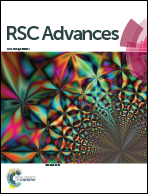Oxidative desulfurization of dibenzothiophene using a catalyst of molybdenum supported on modified medicinal stone
Abstract
In this paper, the performance of catalytic oxidative desulfurization from model oil was studied using a catalyst of molybdenum supported on modified medicinal stone (Mo/MMS). The catalyst was successfully prepared by the sorption method and characterized by scanning electron microscopy (SEM), X-ray diffraction (XRD), Fourier transform infrared spectroscopy (FT-IR) and N2 adsorption–desorption. The removal rate of dibenzothiophene (DBT) reached 97.5% within 60 min under conditions of catalyst dosage of 0.50 g, a reaction temperature of 100 °C, an oxidant/sulfur molar ratio (O/S) of 5.0 and the volume of model oil of 20 ml. The Box–Behnken design was used to evaluate the influence of the main operating parameters, including oxidation temperature (40–120 °C), oxidation time (40–80 min) and O/S (1.0–5.0) on DBT removal. The optimum values were found to be 103 °C, 62 min and 4.0, respectively. The removal rate of DBT reached a maximum at 98.1%. Statistical results also showed the degree of importance was: O/S > oxidation temperature > oxidation time. Sulfur removal dropped to 92.2% from 98.1% when the catalyst was reused 5 times. These results prove that the Mo/MMS catalyst could be cost-effective for removal of DBT from oil.


 Please wait while we load your content...
Please wait while we load your content...